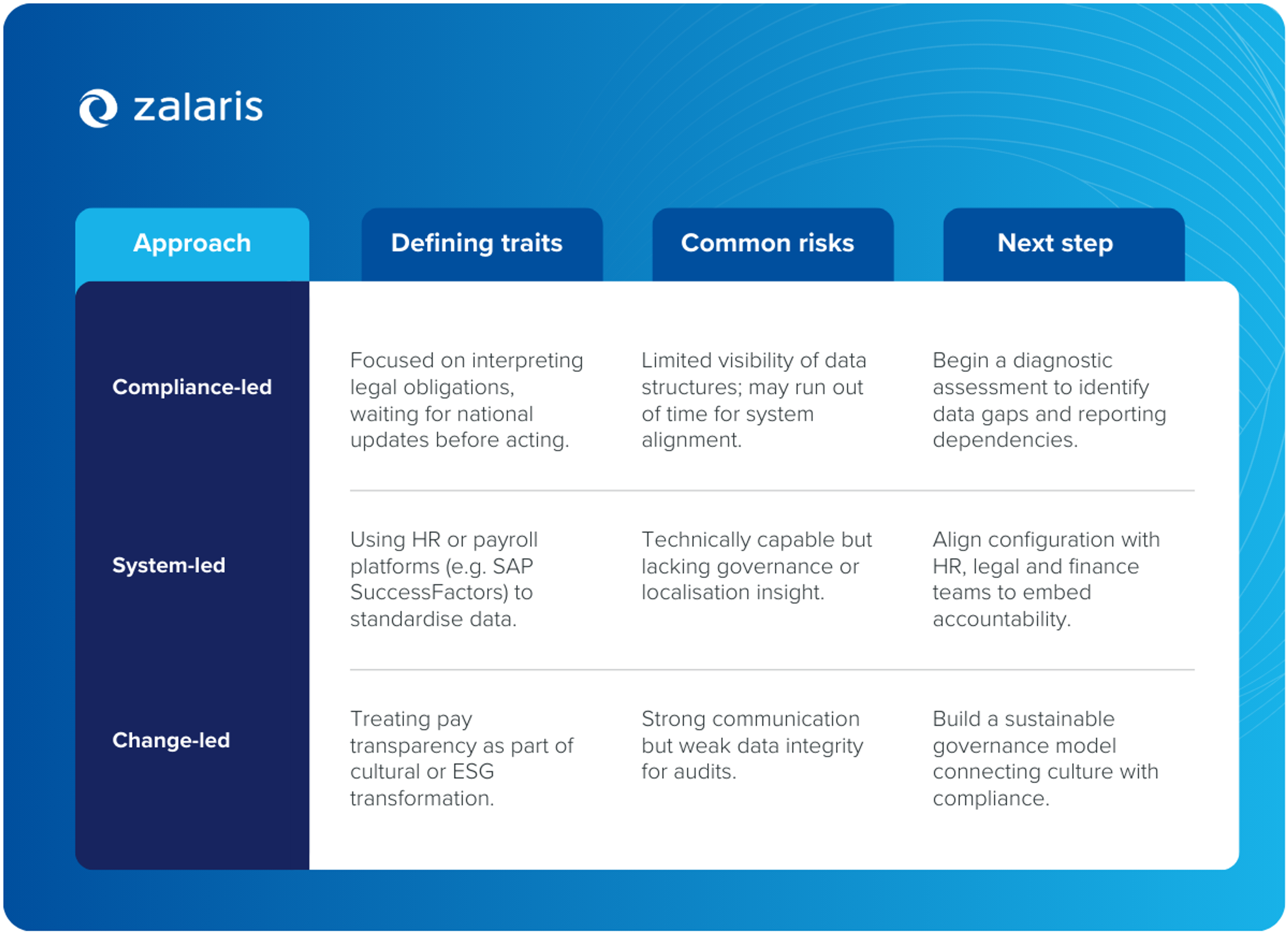EU pay transparency directive: The 2026 deadline reshaping HR across Europe
In less than a year, new rules will require every employer in the European Union – from multinationals to mid-sized firms – to make pay practices visible, measurable and fair.

A major shift is coming to European HR and payroll. By 7 June 2026, every EU Member State must transpose the EU Pay Transparency Directive (EU 2023/970) into national law, introducing new obligations that fundamentally reshape how organisations structure, document and communicate pay.
For HR, this is far more than a compliance deadline. It marks a turning point in how employers define fairness, justify pay decisions and build trust with their workforce.
While the Directive’s gender pay-gap reporting obligations initially apply to organisations with 250 or more employees, many of its transparency requirements apply to all employers, regardless of size. And because thresholds are based on total EU headcount, mid-sized companies with smaller country operations may find themselves in scope sooner than expected. Over time, reporting thresholds will also drop, bringing even more organisations into the framework.
Crucially, the Directive goes well beyond payroll calculations. It introduces a structural shift in how HR, reward, legal and leadership teams think about pay clarity, governance, accountability and data quality across the employee lifecycle. In practice, this means rethinking how pay is designed, evaluated, communicated and defended - from job architecture and salary ranges to recruitment, progression and employee information rights.
From principle to proof: The five new pillars of pay transparency
For decades, equal pay has been a goal organisations strived for. But now, the directive sets expectations for employers to show how pay is structured, evaluated and justified using objective, evidence-based governance.
These interlinked obligations that will require HR, payroll, rewards and legal teams to rethink how data, governance and communication intersect.
1. Pay range disclosure in job postings:
Employers must state expected pay or pay bands in job advertisements or share them before the first interview. Asking about salary history will no longer be permitted as it is now considered a form of pay discrimination.
2. Gender-neutral pay and progression criteria:
Pay and career progression must be based on objective, gender-neutral factors such as skills, effort, responsibilities and working conditions.
3. Employee right to information:
Employees can request both their own pay data, the median pay for men and women doing work of equal valye, and the criteria used to determine pay and progression.. Employers must respond within two months.
4. Gender pay gap reporting:
Employers with 250 or more employees across EU operations must publish annual gender pay gap reports, including median differences and variable-pay differences between men and women. Additional thresholds will be phased in later.
5. Action on unexplained pay gaps:
If differences of more than 5% within a comparator group cannot be objectively justified, organisations must conduct a joint pay assessment and take corrective measures.
According to the European Commission, these measures aim to “strengthen the right to equal pay for equal work” and ensure that transparency becomes a structural, not symbolic, part of HR practice.
The gender pay gap: Myths and reality in 2026
Across Europe, the gender pay gap remains one of the most persistent and misunderstood forms of gender discrimination. As HR leaders prepare for the EU Pay Transparency Directive, it is important to look past headlines and understand what the data really tells us.
The European Commission estimates that women in the EU still earn around 12 percent less per hour on average than men, a figure that has remained consistent over the past decade. On the surface, this suggests a clear imbalance. Yet once factors such as role, working hours, seniority and sector are considered, the picture becomes more complex. Analysis by the Economic Policy Institute shows that while part of the gap can be explained by these variables, a portion remains “unexplained” – often reflecting cultural or structural barriers that extend beyond pay systems themselves.
Transparency, meanwhile, is often presented as an immediate fix. However, less than 50% of member states currently require private-sector organisations to report gender pay gap data, and even where transparency is mandated, closing the gap depends on governance, data quality and sustained leadership engagement.
Regional variations add another layer of complexity. Euronews data shows that pay gaps range widely across Europe, with some countries reporting differences above 17% and others falling into single digits. This means that a one-size-fits-all approach will not suffice. The Directive’s common standards will bring much-needed consistency, but each national labour market will require a nuanced set of policies.
For organisations, the challenge is not only to comply with reporting obligations but to ensure that transparency leads to meaningful action. The Directive requires employers to address pay gaps of more than five percent when they cannot be objectively justified. This places greater importance on ongoing pay equity reviews, gender-neutral job evaluation frameworks and strong pay governance. .
As 2026 approaches, the most successful HR leaders will be those who treat transparency not as an administrative burden, but as an opportunity to build trust and demonstrate fairness in practice.
For practical guidance on reporting and auditing, the OECD has published implementation guidance for gender pay gap reporting that will help employers align their reporting approaches.
One directive, many realities: Pay transparency in every EU member state
While the Directive sets a single European standard, its implementation across countries will vary. Each member state must transpose the Directive into national law by June 2026, which means implementation timelines and enforcement mechanisms will vary
This can look different for every country your organisation operates in:
Germany
As Europe’s largest economy, Germany has been slow to legislate, with political stalemates and postponed drafts. Officials promise minimal bureaucracy, but the courts have taken a more proactive stance. Recent Federal Labour Court rulings confirm that equal pay principles are already enforceable through case law, meaning employees can pursue claims even before national legislation is finalised.
The Netherlands
The Netherlands has taken the unusual step of officially delaying its transposition until January 2027, citing administrative burdens and political instability. . Once the EU deadline passes, certain provisions may still be invoked directly through courts if national legislation is delayed.
France
France stands out for its robust approach, building on its existing gender equality index and lowering the reporting threshold to companies with 50 employees. Rather than merely adopting the directive, France is expanding its scope, setting a high standard that other countries may eventually emulate.
Poland
Poland acted swiftly but only partially, enacting a law focused on recruitment transparency, including publishing pay ranges and adopting gender neutral job titles. However, key elements like joint pay assessments, audits, and broader reporting remain unaddressed, leaving significant gaps in enforcement.
Belgium
Belgium’s complex federal structure means only the French-speaking community has transposed the directive, while other regions are still negotiating. This results in different rules within the same country, confusing employers, employees, and unions alike. Employers operating across multiple Belgian regions must prepare for differing obligations within the same country
Spain
Spain already operates strong equality legislation, yet additional updates are required to meet the Directive’s recruitment transparency requirements and revised reporting thresholds. Alignment is progressing, but employers should anticipate further changes as national law is finalised.
Italy
Italy has yet to present any draft legislation, indicating a delayed response that will likely incorporate the directive into existing gender equality codes in the future.
The Nordics
Countries like Denmark, Sweden, and Finland already have comprehensive pay data collection and equality reporting systems. These countries already operate robust transparency frameworks, so alignment may require incremental updates rather than major changes.
Czech Republic & Malta
Both countries have outlawed pay secrecy but stopped short of implementing deeper measures like job evaluations and pay audits, resulting in incomplete compliance.
Eastern Europe
Countries such as Austria, Hungary, and Romania are progressing more slowly, meaning employers may need to rely on EU-level obligations or case law until national legislation advances.
United Kingdom (non-EU)
Although no longer subject to EU law, the UK has required gender pay gap reporting since 2017 and remains a regional benchmark for transparency.
For multinational employers, this diversity means that compliance cannot be handled country by country. Instead, HR leaders must develop a core EU compliance model that adapts to local variations in data governance, reporting and enforcement.
Why acting early matters
Waiting for final national laws before starting readiness work is a risky choice. Several obligations, including employee information rights, pay-range disclosure and gender-neutral job evaluation criteria - apply regardless of when national legislation is finalised. Building the systems, cleaning the data and creating governance that will stand up to audit takes time. The OECD notes that pay-transparency reforms require robust data infrastructure and governance capacity.
Typical readiness activities include:
- Reviewing data quality and structure across HR and payroll systems.
- Aligning job architecture with gender-neutral criteria.
- Enabling systems to manage pay-range visibility, employee data requests and gender pay gap calculations.
- Designing governance and communication plans to manage disclosure and employee rights.
Those who start early gain more than compliance: They signal fairness, strengthen employer reputation, and align with broader ESG and social impact expectations now shaping global workforce reporting.
The real readiness divide
A comprehensive readiness strategy depends on a clear path to integration - especially for organisations operating across multiple EU countries, where data sits in different systems, job structures vary by market and governance spans HR, reward, legal and finance. The Directive requires organisations to align policy, data and systems across all EU operations, not just within individual countries.
To achieve cohesive and complete integration, organisations typically choose these three readiness approaches:

Pay transparency and local readiness: Key measures for employers in the EU
Because the Directive aggregates employee counts across EU countries, many organisations will fall within scope for certain obligations, even where local entities are small. This means readiness cannot be left to national HR teams alone - it requires coordinated EU-wide governance, consistent job structures and aligned data foundations.
Forward-thinking employers are already:
- Mapping HR and payroll data across borders to identify inconsistencies.
- Evaluating existing roles based on four neutral criteria as outlined by the EU: skills, effort, responsibility, and working conditions.
- Building shared governance structures for EU-level and national reporting.
These steps not only support compliance but also lay the groundwork for future automation, analytics and ESG reporting.
How Zalaris can support your journey
Zalaris supports organisations across Europe in preparing for the Directive by strengthening the job architecture, data foundations, governance structures and system capabilities needed for EU-wide transparency. Through a Pay Transparency Readiness Assessment, our experts:
- Benchmark readiness against Directive requirements and national progress.
- Identify system and data gaps across countries and vendors.
- Define the sequencing and governance needed for sustainable compliance.
- Provide region-specific insights from over two decades of HR and payroll experience.
Whether you employ 300 or 30,000 people across Europe, Zalaris helps turn regulatory complexity into a clear, actionable roadmap.
By understanding current levels of compliance and upcoming requirements, HR leaders can connect policy, systems and people – ensuring that by 2026, pay transparency becomes a source of trust, not tension.
Book your pay transparency readiness assessment now
Understand your organisation’s position, identify gaps, and build a roadmap to compliance, confidence, and credibility with Zalaris.
Table of Contents
- From principle to proof: The five new pillars of pay transparency
- The gender pay gap: Myths and reality in 2026
- One directive, many realities: Pay transparency in every EU member state
- Why acting early matters
- The real readiness divide
- Pay transparency and local readiness: Key measures for employers in the EU
- How Zalaris can support your journey

